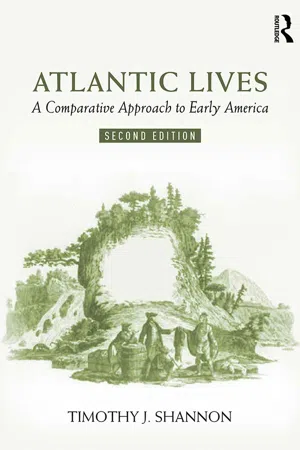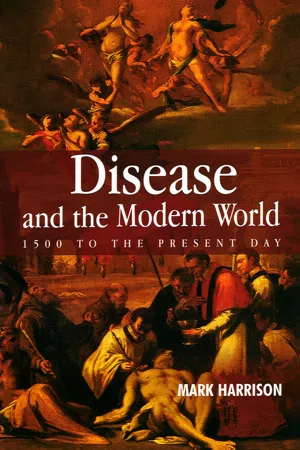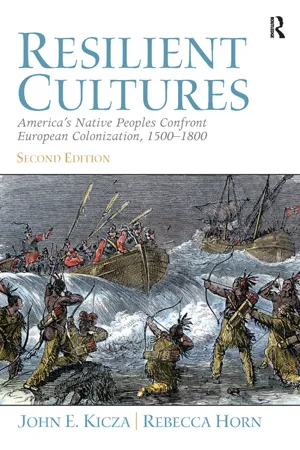Columbian Exchange Diseases
The Columbian Exchange Diseases refer to the transfer of infectious diseases between the Old World and the New World following the arrival of European explorers in the Americas. This exchange led to devastating consequences for the indigenous populations, as they had no immunity to diseases such as smallpox, measles, and influenza. The resulting epidemics caused significant population declines in the Americas.
6 Key excerpts on "Columbian Exchange Diseases"
- eBook - ePub
Atlantic Lives
A Comparative Approach to Early America
- Timothy Shannon(Author)
- 2019(Publication Date)
- Routledge(Publisher)
...2 The Columbian Exchange Figure 2.1 Smallpox among the Nahuatl in Sixteenth-Century Mexico. Of the many diseases transmitted across the Atlantic in the Columbian Exchange, smallpox was the most deadly for Native Americans (see Selection 2). Considered a childhood disease in Europe, in America it led to fatality rates that ranged from 30 to 90 percent of infected populations. This image of Native Americans suffering from smallpox comes from a sixteenth-century Spanish collection about the Aztecs. Source: Florentine Codex, Book XII folio 54. Bernardino de Sahagún, Historia general de las cosas de la Nueva España (1540–1585). Introduction The passage of human beings between the Old World and the New led to a much wider transfer of plant and animal life commonly known as the Columbian Exchange. Some of this exchange occurred by design, such as when Old World farmers planted American crops in their fields; other times, the exchange was inadvertent, such as when colonists unwittingly introduced new diseases to Native American populations. Whether purposeful or accidental, such exchanges forever altered the nature of plant, animal, and human life on both sides of the Atlantic. Formerly isolated ecosystems became intertwined and transformed in the process. Some species experienced extinction or near extinction, while others flourished in new surroundings unchecked by natural enemies. While scholars have typically studied the human actors involved in this drama, we cannot appreciate the full impact of the Columbian Exchange without considering the other forms of life it affected. The most profound changes wrought by the Columbian Exchange resulted from the transmission of microbes from the Old World to the New. European sailors, explorers, traders, and colonists brought to the Americas a number of diseases to which Native Americans had had no previous exposure, and therefore, no natural immunities...
- Mark Harrison(Author)
- 2013(Publication Date)
- Polity(Publisher)
...4 The World beyond Europe New World peoples, Old World diseases The world that emerged from the Renaissance and the Reformation was a world that looked increasingly to the future. Though scholars and statesmen still revered Classical civilization, they looked forwarded in confident anticipation of progress. They looked increasingly beyond Europe, too. The rise of the West depended very largely on its willingness to seek out, and ultimately to control, new lands, commodities and peoples. 1 In the process, Western medicine was confronted with new challenges and opportunities, in the forms of disease and medicinal plants. And with the movement of peoples came the passage of microbes, hastening what Emmanuel Le Roy Ladurie has described as the ‘unification of the globe by disease’. 2 But while germs were distributed far more widely than before, the burden of disease was far from equal. Long exposure to infections like smallpox and measles gave Europeans an immunity that the peoples of America and the Pacific lacked. In the Old World there were more domesticated animals, which acted as reservoirs of infection, and all the key centres of population had long been joined by trade, which ensured regular mixing of germs. 3 Once Europeans landed in the New World, Old World infections spread rapidly and fatally among the local inhabitants, leaving Europeans relatively unscathed. Spanish censuses and tax surveys suggest that the indigenous population halved within two decades after the first reported epidemics. 4 The best-known account of these epidemics is Alfred W. Crosby’s book, The Columbian Exchange (1972). 5 Crosby argues that the importation of lethal pathogens was one aspect of a process of ‘ecological imperialism’ that allowed white settlers rapidly to attain dominance over Native Americans. 6 Without the advantage conferred by disease, he insists, the Spanish would never have been able to overcome the militaristic civilizations of Mexico and the Andes...
- eBook - ePub
Plagues upon the Earth
Disease and the Course of Human History
- Kyle Harper(Author)
- 2021(Publication Date)
- Princeton University Press(Publisher)
...Only later, with bronze and iron metallurgy, the domestication of donkeys and horses, and the rise of true cities and large empires, did more and more respiratory pathogens (like the agents of measles and smallpox) enter the permanent human disease pool. Civilizations in the Bronze and Iron Ages also became more interconnected, and long-distance networks allowed diseases to circulate across Europe, Asia, and Africa during this period. Great killers like tuberculosis and malaria diffused across the Old World, while the most peculiar and most explosive of the ancient diseases—bubonic plague—took advantage of the worldwide network of rats that human progress had unintentionally constructed. A third energy revolution, of sorts, was brought about by the regular crossing of the Atlantic Ocean. The voyages of Christopher Columbus reconnected the hemispheres after millennia of near total separation. The diverse peoples of the Americas were devastated by the introduction of European germs and the imposition of European colonization. Equally deserving of attention is the gradual reunification of the tropics, as equatorial germs migrated westward over the ocean. The result was a new geography of disease in the Americas, mirroring the gradients of health in the Old World. Contact with the New World was also transformative for Europe, Africa, and Asia. Atlantic-facing European societies, which were gifted with some of the naturally healthiest environments on the planet, were now at the center rather than the periphery of the world’s most important economic networks. At a decisive moment of global history, these societies weathered the “general crisis” of the seventeenth century, whose biological dimensions are sketched in chapter 9...
- eBook - ePub
- David Arnold(Author)
- 2021(Publication Date)
- Manchester University Press(Publisher)
...We know as yet too little about the nature and extent of disease (and other causes of mortality) among the inhabitants of the Americas, Black Africa or Polynesia before the Europeans’ arrival, even about cholera and smallpox in India before the establishment of British rule, to make such claims with confidence. It is probably a mistake to assume that pre-colonial societies, even those that existed in virtual isolation from the rest of the world, enjoyed an idyllic existence free from endemic disease and the periodic suffering caused by famine, warfare and pestilence. 22 It may be that the spate of epidemics which afflicted many societies following the white man’s arrival have assumed significance simply because Europeans were on hand to record them. Many earlier epidemiological and ecological catastrophes may have preceded them without finding their way into any surviving historical account. It seems improbable, for example, that the ancient trading links between India and East Africa had not brought epidemics of smallpox in their wake long before the nineteenth century, or that pilgrimage routes to and from Mecca had not for centuries blazed epidemic trails across North Africa, the Middle East and western Asia. But, even with that important caveat in mind, it still seems likely that the scale and intensity of European intervention in the period from the late eighteenth to the early twentieth centuries had a massive, and possibly unprecedented, epidemiological and environmental impact on the peoples of Africa, Asia and Oceania. The reasons are worth summarising. Europeans forged new epidemiological links, either by relaying diseases (like smallpox and measles) long present in Europe or by establishing ties between parts of the world that had previously had few (if any) such connections with each other...
- Lori Jones, Lori Jones(Authors)
- 2022(Publication Date)
- Routledge(Publisher)
...Lamb (1977, 1966) and Clarence Glacken (1967), among others – tended instead to look at humans and their interactions with the environment, exploring climatic and landscape change over time within familiar European historical temporal and spatial frameworks (McNeill, 2010a, 2003). Despite Le Roy Ladurie’s earlier broaching of the topic, it wasn’t really until Alfred W. Crosby’s works appeared – The Columbian Exchange: Biological and Cultural Consequences of 1492 (1972) and Ecological Imperialism: The Biological Expansion of Europe, 900–1900 (1986) – that diseases of plants, animals, and humans were systematically pulled into the broader temporal/spatial narratives of human and environmental history. Crosby examined the ecological underpinnings and impacts of a European expansion and colonialism endeavour that substantially altered environmental and disease landscapes along with their human populations in Europe, Asia, and the Americas. Subsequent scholars adapted the scope of Crosby’s take on history-through-ecology and disease to explore Africa (Curtin 1998), China (Elvin and Ts’ui-jung 1998 ; Marks 1998), the Indian Ocean (Arnold 1991), and England (Dobson 1997), among other places. Over the past twenty years, much additional scholarship has followed, as historians and other scholars have explored environment–disease links in specific pre-modern geographical regions, including China (Marks 2017), Egypt (Borsch 2005; Derr 2019 ; Mikhail 2012), the Mediterranean littoral (Davis 2007 ; Gratien 2017 ; Tabak 2009), Africa (Akyeampong 2006), Eurasia (Campbell 2016 ; Green 2018), and the American and Indian colonies (Sivaramakrishnan 2011 ; Wear 2011). Cross-cultural approaches to the topic have also appeared recently (Bretelle-Establet et al. 2019). The impact of disease on entire ancient civilizations, such as Neolithic societies or the Roman Empire, has likewise received attention (Harper 2016 ; 2017; Little 2007 ; Rascovan et al. 2019 ; Selassie 2011)...
- eBook - ePub
Resilient Cultures
America's Native Peoples Confront European Colonialization 1500-1800
- John Kicza, Rebecca Horn(Authors)
- 2016(Publication Date)
- Routledge(Publisher)
...8 Enduring Connections between the New World and the Old T he preceding chapters have considered the nature of the native peoples of the Americas and how they were affected by and responded to European colonization. The first part of this chapter examines the impact of the incorporation of the Americas into the environmental and economic frameworks of the Old World, a process commonly termed “The Columbian Exchange.” For the first time, the Atlantic Ocean became a primary arena for the movement of people, diseases, animals, plants, and precious metals. This process transformed the environment of the Americas as much as it did the rest of the world. The following five sections consider the scope and impact of each of these emerging connections between the New World and the Old. A concluding section examines certain lasting patterns and trends in the history of Indian–European interactions in the colonial period. Before the discovery of the Americas, Western Europe participated only episodically in the exchange systems of the Old World. Located on the western periphery of the three continents of Africa, Asia, and Europe that constituted this trade zone, Western Europe produced few commodities or manufactured goods that could compete in African or Asian markets. Hence, it scarcely participated in the dynamic and flourishing trading networks centered in the Indian Ocean and the South China Sea. The complex economies of South Asia and China routinely shipped merchandise to East Africa, throughout Southeast Asia, and to the Spice Islands (modern Indonesia) and the Philippines. The Movement of Peoples The Americas had only minimal impact on the Old World in the exchange of people. Few Native Americans journeyed to Europe, and fewer still remained for very long. Europe certainly did not need people from America as settlers or laborers. Early explorers of the Americas, though, frequently kidnapped small numbers of young natives to take back with them...





